After the successful separation of Chandrayaan-3’s Vikram lander module from the propulsion module on Thursday, former Indian Space Research Organisation (ISRO) scientist, Mylswamy Annadurai, said that the final and important thing now of the lander is its secure landing on the Moon.
The former ISRO scientist and Padma Shri awardee said that the Vikram lander now has to take its own action and further it has to separate after which the major event comes.
“So now the important and final thing is… softly and securely landing on the moon. For that, the lander has to separate from the propulsion module. So as of now, all the modules of the propulsion system have made its functionalities and it has done its job,” he said.
“Now Vikram has to take its own course of action. Further, it has to separate. So even after separating, then the major event comes. A major event is the 4800 Newton thrusters. They have to fire to take it to the lower orbit. That will also be done in two steps and ensuring that all the systems are working properly these two steps will go down, put a 100-kilometre orbit. Then from 100 go to the 30-kilometer orbit… that’s very very vital. But when it’s going very closer, closer to the Earth,” he said while speaking to ANI.
He further said that So the position of the module has to be ascertained properly. So then from the 30 kilometre onwards, how to move, how to thrust to fire, what orientation to fire, and whether along it will reduce the velocity in the horizontal. Then it has to composite vertical also it has to vertical fall, also it has to reduce. So that way a lot of manoeuvres to be done. And while doing it, it has to make sure that it is going on the proper path. So already loaded pictures of the lunar terrain will be there. Check against that and try to identify the place where it’s supposed to land. It is also supposed to have been already loaded in the system.
“So all these activities will be done by the lander. The lander will start its real action only from today onwards…,” Annadurai added.
India’s Chandrayaan-3 mission marked another giant leap in its lunar quest as the ‘Vikram’ lander module of the spacecraft successfully separated from the propulsion module on Thursday.
The Chandrayaan-3 mission’s lander is named after Vikram Sarabhai (1919–1971), who is widely regarded as the father of the Indian space programme.
On Wednesday, the spacecraft carried out the final lunar-bound orbit reduction manoeuvre of the Chandrayaan-3 spacecraft, a week ahead of its scheduled landing on the south pole of the moon on August 23.
A GSLV Mark 3 (LVM 3) heavy-lift launch vehicle was used for the launch of the spacecraft that was placed in the lunar orbit on August 5 and since then it has been through a series of orbital manoeuvres been lowered closer to the moon’s surface.
It has been a month and two days since the Indian Space Research Organisation launched the Chandrayaan-3 mission on July 14. The spacecraft was launched from the Satish Dhawan Space Centre in Andhra Pradesh’s Sriharikota.
ISRO is bidding to make a successful soft landing on the moon, which will make India the fourth country in the world to achieve the feat after the United States, Russia and China.
Chandrayaan-3 is the ISRO’s follow-up attempt after the Chandrayaan-2 mission faced challenges during its soft landing on the lunar surface in 2019 and was eventually deemed to have failed its core mission objectives.
The key scientific outcomes from Chandrayaan-2 include the first-ever global map for lunar sodium, enhancing knowledge on crater size distribution, unambiguous detection of lunar surface water ice with IIRS instrument and more.






















